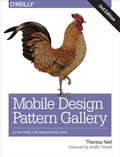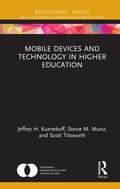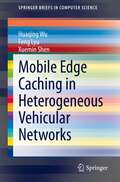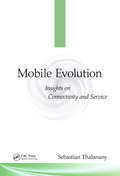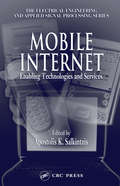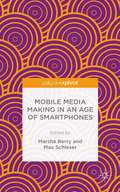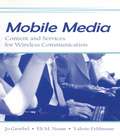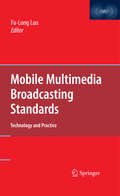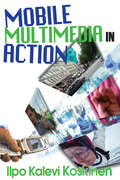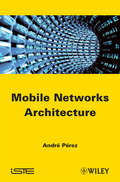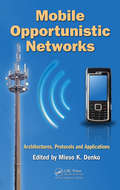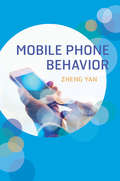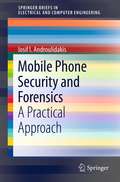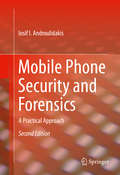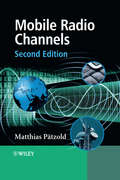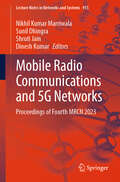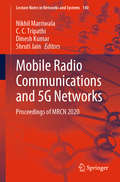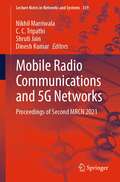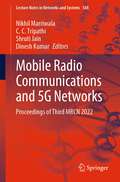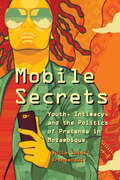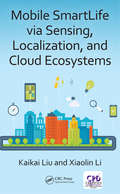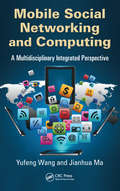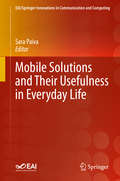- Table View
- List View
Mobile Design Pattern Gallery: UI Patterns for Smartphone Apps
by Theresa NeilWhen you’re under pressure to produce a well-designed, easy-to-navigate mobile app, there’s no time to reinvent the wheel—and no need to. This handy reference provides more than 90 mobile app design patterns, illustrated by 1,000 screenshots from current Android, iOS, and Windows Phone apps.Much has changed since this book’s first edition. Mobile OSes have become increasingly different, driving their own design conventions and patterns, and many designers have embraced mobile-centric thinking. In this edition, user experience professional Theresa Neil walks product managers, designers, and developers through design patterns in 11 categories:Navigation: get patterns for primary and secondary navigationForms: break industry-wide habits of bad form designTables: display only the most important informationSearch, sort, and filter: make these functions easy to useTools: create the illusion of direct interactionCharts: learn best practices for basic chart designTutorials & Invitations: invite users to get started and discover featuresSocial: help users connect and become part of the groupFeedback & Affordance: provide users with timely feedbackHelp: integrate help pages into a smaller form factorAnti-Patterns: what not to do when designing a mobile app
Mobile Devices and Technology in Higher Education: Considerations for Students, Teachers, and Administrators (NCA Focus on Communication Studies)
by Scott Titsworth Jeffrey H. Kuznekoff Stevie M. MunzThis book examines key issues at the intersection of education and technology by addressing the question that most educators face—how do we use technology to engage students in the learning process and enhance learning? Problematizing the view that technology is the default solution to a host of problems facing education, while also recognizing that technology has an important place in a variety of education levels, the book provides readers with clear insights on technology and learning from a variety of perspectives from communication studies, education, and related disciplines. This volume is an essential read for scholars and teachers working in the area of elementary education. It will also be of interest to academics working in the area of education, postsecondary education, and learning and can be used as an ancillary text in graduate-level seminars.
Mobile Edge Caching in Heterogeneous Vehicular Networks (SpringerBriefs in Computer Science)
by Xuemin Shen Feng Lyu Huaqing WuTo support smart vehicular services especially in the future driverless era, the vehicular networks are expected to support high-bandwidth content delivery and reliable accessibility of multifarious applications. However, the limited radio spectrum resources, the inflexibility in accommodating dynamic traffic demands, and the geographically constrained fixed infrastructure deployment of current terrestrial networks pose great challenges in ensuring ubiquitous, flexible, and reliable network connectivity. This book investigates mobile edge content caching and delivery in heterogeneous vehicular networks (HetVNets) to provide better service quality for vehicular users with resource utilization efficiency enhancement. Specifically, this book introduces the background of HetVNets and mobile edge caching, provides a comprehensive overview of mobile edge caching-assisted HetVNet techniques in supporting vehicular content delivery, and proposes/designs mobile edge content caching and delivery schemes in different HetVNet scenarios respectively to enhance vehicular content delivery performance. Afterward, this book outlines open issues and research directions in future mobile edge caching-assisted space-air-ground integrated vehicular networks. The topics addressed in this book are crucial for both the academic community and industry, since mobile edge caching in heterogeneous networks has become an essential building block for the communication systems. The systematic principle of this book provides valuable insights on the efficient exploitation of heterogeneous network resources to fully unleash their differential merits in supporting vehicular applications. In addition, this book considers different HetVNet scenarios from terrestrial HetVNets to air-ground HetVNets and space-air-ground HetVNets, which can provide a general overview for interested readers with a comprehensive understanding of applying mobile edge caching techniques in enhancing vehicular content delivery performance, and offer a systematized view for researchers and practitioners in the field of mobile edge caching to help them design and optimize the desired vehicular content delivery systems.Provides in-depth studies on mobile edge content caching and delivery scheme design for three typical HetVNet scenarios;Comprehensively covers the analysis, design, and optimization of the mobile edge content caching-assisted HetVNets;Systematically addresses vehicle mobility, network service interruptions, and dynamic service request distribution issues in the mobile edge content caching and delivery.
Mobile Evolution: Insights on Connectivity and Service
by Sebastian ThalananyThis book presents insights, interpretations, concepts, and interdependent views-in the landscape of mobile connectivity and service-that emphasize the significance of a harmonious interplay, cooperation, and coalescing of a variety of interdisciplinary domains of science and art. Mobile Evolution: Insights on Connectivity and Service explores the forward-looking and enabling capabilities of mobile connectivity and service in the context of long term evolution (LTE) systems and multimedia services, as viewed through a lens of human experience. It provides information and guidelines pertaining to the strategies and technologies associated with the next-generation mobile ecosystem.
Mobile Internet: Enabling Technologies and Services (Electrical Engineering And Applied Signal Processing Ser.)
by Apostolis K. SalkintzisConsumers want it, businesses are demanding it. The migration of Internet services to a mobile environment is inevitable. But while the ability to be on the go and connected to the Internet sets the stage for increased efficiency and productivity, many technical challenges associated with user mobility and wireless connectivity remain.Mobil
Mobile Media Making in an Age of Smartphones
by Marsha Berry Max SchleserWith the rise of smartphones and the proliferation of applications ("apps"), the ways everyday media users and creative professionals represent, experience, and share the everyday is changing. With the overlay of location-based services, these experiences and representations are providing new social, creative, and emotional cartographies. This collection discusses the prospects of the proliferation of mobile and digital filmmaking opportunities, from videographic citizen journalism to networked, transmedia collaborative filmmaking and photography, and the embedding of filmmaking and photography in social media practice. The contributors reflect on emergent creative practices as well as digital ethnographies of new visualities and socialities associated with smartphone cameras in everyday life.
Mobile Media: Content and Services for Wireless Communications (European Institute for the Media Series)
by Eli M. Noam Jo Groebel Valerie FeldmannThe proliferation of mobile media in recent years is an international phenomenon, with billions of devices sold annually. Mobile communications are now moving beyond individualized voice to mass media content--text, voice, sound, images, and even video. This will create new types of content that allow media companies and users to interact in new ways. There is a strong interest from the media and telecom industries in what manner of applications and content can be distributed in that fashion, and at what cost. To answer these questions, the book provides 18 chapters from internationally renowned authors. They identify likely types of content such as news, entertainment, peer-to-peer, and location-specific information; evaluate the economics, business models, and payment mechanisms necessary to support these media; and cover policy dimensions such as copyright, competitiveness, and access rights for content providers.This volume takes the reader through the various elements that need to be considered in the development of third generation (3G) content, and explains pitfalls and barriers. The result is a volume of interest to business professionals, academics, and policy makers.The book is international in focus and a glossary of terms is provided. There are few publications available which give an overview of this rapidly changing field.
Mobile Multimedia Broadcasting Standards
by Fa-Long LuoThis volume provides a comprehensive and cohesive compilation of multi-standards and systems for mobile multimedia broadcasting. The material includes coverage of the basic principles, algorithms, and design trade off as well as examples of software and hardware that have been implemented at the system level. The first part of the book deals with system, implementation, compatibility and comparison of all the co-existing standards related to mobile TV and multimedia broadcasting including T-DMB, DAB, DVB-H/T, CMMB, Media-FLO, ISDB-T and WiMAX, ATSC digital TV and NTSC analog TV. The second part covers fundamental principles, algorithms, design and testing for baseband processing in mobile multimedia broadcasting. The third part consists of compression, transmission, error concealment, quality assessment and real-time implementation of video coding in broadcasting systems with emphasis on H.264 and AVS-M. The last four chapters are on the standards for audio coding, classification and surround effects. An overview of China's DRA audio coding standard and MPEG-4 AAC standard family (AAC, High Efficiency AAC and High Efficiency AAC Version 2) is given. The work also explains the general concepts behind spatial audio coding which are playing a very important role in digital audio/multimedia broadcasting systems for multi-channel contents. Mobile Multimedia Broadcasting Standards: Technology and Practice is an invaluable reference for engineers, researchers, broadcasters, manufacturers, network operators, software developers, content providers and others involved in the delivery of multimedia enriched contents to mobile systems.
Mobile Multimedia in Action
by Ilpo Koskinen"Mobile Multimedia in Action" displays a revealing picture of how people communicate using camera phones and other mobile multimedia devices. With such devices spreading faster than practically any other new technology, questions about how these devices are being used (and abused) to capture and distribute embarrassing or raunchy images and content, and what should be done about it, are surfacing. This volume presents the first detailed study of the use of these devices. Using a variant of social science research known as ethnomethodology, Koskinen explores the kinds of images people take with camera phones and how they use sound to enhance these images. The book asks two main questions. First, what kinds of methods of expression, such as visuals or sound, do people use when they design multimedia messages? Second, how do people interact with and respond to each other through mobile multimedia devices? Koskinen has a broader objective centering on the impact of these devices on human relationships and society at large. He asks, What do people do with these devices? Is mobile telephony moving toward a more practical direction, or will it simply become a visual chatty channel fit for gossip but not for real news or other practical purposes? What kind of social activities and organizations does it best serve - peer-to-peer networks or institutional ones? Koskinen examines these questions from three unique perspectives: the design elements of mobile multimedia, which considers methods of expression people use in designing multimedia messages; mobile multimedia as interaction, which looks into how people interact with each other using this technology and makes a case for studying multimedia as a naturally occurring activity; and mobile multimedia in society, which searches for answers as to the societal consequences of mobile multimedia usage. A groundbreaking work, "Mobile Multimedia in Action" will be a fascinating read for both multimedia device professionals and everyday users alike. Providing a glimpse into the future, Koskinen asks where mobile multimedia technology is taking mankind and society.
Mobile Networks Architecture
by André PérezThis book explains the evolutions of architecture for mobiles and summarizes the different technologies: – 2G: the GSM (Global System for Mobile) network, the GPRS (General Packet Radio Service) network and the EDGE (Enhanced Data for Global Evolution) evolution; – 3G: the UMTS (Universal Mobile Telecommunications System) network and the HSPA (High Speed Packet Access) evolutions: - HSDPA (High Speed Downlink Packet Access), - HSUPA (High Speed Uplink Packet Access), - HSPA+; – 4G: the EPS (Evolved Packet System) network. The telephone service and data transmission are the two main services provided by these networks. The evolutions are fundamentally dictated by the increase in the rate of data transmission across the radio interface between the network and mobiles. This book is intended as a readily understandable support to help students and professionals wishing to quickly acquire the main concepts of networks for mobiles understand the technologies deployed.
Mobile Opportunistic Networks: Architectures, Protocols and Applications
by Mieso K. DenkoFrom fundamentals to advanced concepts, this book provides comprehensive technical coverage of this rapidly emerging communications technology. The first section focuses on modeling, networking architecture, and routing problems. The second section examines opportunistic networking technologies and applications. Supplying detailed discussions of key research challenges and open issues, this comprehensive resource provides a clear understanding of industrial and professional standards, communication architectures, network algorithms and protocols, emerging applications, and the latest experimental studies-including simulation tools and implementation test beds.
Mobile Persuasion: 20 Perspectives on the Future of Behavior Change
by B. J. FoggThe mobile phone will soon become the most powerful channel for persuasion. This book presents 20 perspectives on how mobile devices can be designed to motivate and influence people - and how this emerging trend will change the way you live, work, and play.
Mobile Phone Behavior
by Zheng YanThis book provides the first comprehensive introduction to the newly-emerging science of mobile phone behavior. It presents the unexpected complexity of human mobile phone behavior through four basic aspects of mobile phone usage (users, technologies, activities, and effects), and then explores four major domains of such behavior (medicine, business, education, and everyday life). Chapters open with thoughts on mobile phone usage and behavior from interviews with cell phone users, then present a series of scientific studies, synthesized knowledge, and real-life cases, concluding with complex but highly readable analyses of each aspect of mobile phone behavior. Readers should achieve two intellectual goals: gaining a usable knowledge of the complexity of mobile phone behaviour, and developing the skills to analyze the complexity of mobile phone usage - and further technological behaviors.
Mobile Phone Security and Forensics
by I. I. AndroulidakisMobile Phone Security and Forensics provides both theoretical and practical background of security and forensics for mobile phones. The author discusses confidentiality, integrity, and availability threats in mobile telephones to provide background for the rest of the book. Security and secrets of mobile phones are discussed including software and hardware interception, fraud and other malicious techniques used "against" users. The purpose of this book is to raise user awareness in regards to security and privacy threats present in the use of mobile phones while readers will also learn where forensics data reside in the mobile phone and the network and how to conduct a relevant analysis.
Mobile Phone Security and Forensics
by Iosif I. AndroulidakisThis new edition provides both theoretical and practical background of security and forensics for mobile phones. The author discusses confidentiality, integrity, and availability threats in mobile telephones to provide background for the rest of the book. Security and secrets of mobile phones are discussed including software and hardware interception, fraud and other malicious techniques used "against" users. The purpose of this book is to raise user awareness in regards to security and privacy threats present in the use of mobile phones while readers will also learn where forensics data reside in the mobile phone and the network and how to conduct a relevant analysis. The information on denial of service attacks has been thoroughly updated for the new edition. Also, a major addition to this edition is a section discussing software defined radio and open source tools for mobile phones.
Mobile Radio Channels
by Matthias PätzoldProviding a comprehensive overview of the modelling, analysis and simulation of mobile radio channels, this book gives a detailed understanding of fundamental issues and examines state-of-the-art techniques in mobile radio channel modelling. It analyses several mobile fading channels, including terrestrial and satellite flat-fading channels, various types of wideband channels and advanced MIMO channels, providing a fundamental understanding of the issues currently being investigated in the field. Important classes of narrowband, wideband, and space-time wireless channels are explored in detail with descriptions of efficient simulation methods for mobile radio channels being central. Strong emphasis is placed on the detailed origin of the presented channel models and a high degree of mathematical unity is conveyed. Using the described channel models, the reader can evaluate the performance of wireless communication systems under propagation conditions which are typical for multipath channels in various environments. Introduces the fundamentals of stochastic and deterministic channel models Explores the modelling and simulation of both wideband and narrowband mobile radio channels as well as several classes of MIMO channels Describes general concepts including geometrical, reference and simulation models Discusses several methods for the modelling of given Doppler, delay, and angular profiles Elaborates on methods for the design, analysis, and realisation of efficient channel simulators Examines techniques for the development of fast channel simulators Provides links for downloading MATLAB®, programs enabling the simulation and analysis of the mobile fading channels models presented, on the companion website (www.wiley.com/go/paetzold)
Mobile Radio Communications and 5G Networks: Proceedings of Fourth MRCN 2023 (Lecture Notes in Networks and Systems #915)
by Dinesh Kumar Shruti Jain Nikhil Kumar Marriwala Sunil DhingraThis book features selected high-quality papers from the Forth International Conference on Mobile Radio Communications and 5G Networks (MRCN 2023), held at University Institute of Engineering and Technology, Kurukshetra University, Kurukshetra, India, during August 25–26, 2023. The book features original papers by active researchers presented at the International Conference on Mobile Radio Communications and 5G Networks. It includes recent advances and upcoming technologies in the field of cellular systems, 2G/2.5G/3G/4G/5G, and beyond, LTE, WiMAX, WMAN, and other emerging broadband wireless networks, WLAN, WPAN, and various home/personal networking technologies, pervasive and wearable computing and networking, small cells and femtocell networks, wireless mesh networks, vehicular wireless networks, cognitive radio networks and their applications, wireless multimedia networks, green wireless networks, standardization of emerging wireless technologies, power management and energy conservation techniques.
Mobile Radio Communications and 5G Networks: Proceedings of MRCN 2020 (Lecture Notes in Networks and Systems #140)
by Dinesh Kumar Shruti Jain Nikhil Marriwala C. C. TripathiThe book features original papers by active researchers presented at the International Conference on Mobile Radio Communications and 5G Networks. It includes recent advances and upcoming technologies in the field of cellular systems, 2G/2.5G/3G/4G/5G and beyond, LTE, WiMAX, WMAN, and other emerging broadband wireless networks, WLAN, WPAN, and various home/personal networking technologies, pervasive and wearable computing and networking, small cells and femtocell networks, wireless mesh networks, vehicular wireless networks, cognitive radio networks and their applications, wireless multimedia networks, green wireless networks, standardization of emerging wireless technologies, power management and energy conservation techniques.
Mobile Radio Communications and 5G Networks: Proceedings of Second MRCN 2021 (Lecture Notes in Networks and Systems #339)
by Dinesh Kumar Shruti Jain Nikhil Marriwala C. C. TripathiThis book features selected high-quality papers from the second International Conference on Mobile Radio Communications and 5G Networks (MRCN 2021), held at University Institute of Engineering and Technology, Kurukshetra University, Kurukshetra, India, during 10–12 June 2021. The book features original papers by active researchers presented at the International Conference on Mobile Radio Communications and 5G Networks. It includes recent advances and upcoming technologies in the field of cellular systems, 2G/2.5G/3G/4G/5G and beyond, LTE, WiMAX, WMAN, and other emerging broadband wireless networks, WLAN, WPAN, and various home/personal networking technologies, pervasive and wearable computing and networking, small cells and femtocell networks, wireless mesh networks, vehicular wireless networks, cognitive radio networks and their applications, wireless multimedia networks, green wireless networks, standardization of emerging wireless technologies, power management and energy conservation techniques.
Mobile Radio Communications and 5G Networks: Proceedings of Third MRCN 2022 (Lecture Notes in Networks and Systems #588)
by Dinesh Kumar Shruti Jain Nikhil Marriwala C. C. TripathiThis book features selected high-quality papers from the Third International Conference on Mobile Radio Communications and 5G Networks (MRCN 2022), held at University Institute of Engineering and Technology, Kurukshetra University, Kurukshetra, India, during June 10–12, 2022. The book features original papers by active researchers presented at the International Conference on Mobile Radio Communications and 5G Networks. It includes recent advances and upcoming technologies in the field of cellular systems, 2G/2.5G/3G/4G/5G, and beyond, LTE, WiMAX, WMAN, and other emerging broadband wireless networks, WLAN, WPAN, and various home/personal networking technologies, pervasive and wearable computing and networking, small cells and femtocell networks, wireless mesh networks, vehicular wireless networks, cognitive radio networks and their applications, wireless multimedia networks, green wireless networks, standardization of emerging wireless technologies, power management and energy conservation techniques.
Mobile Secrets: Youth, Intimacy, and the Politics of Pretense in Mozambique
by Julie Soleil ArchambaultNow part and parcel of everyday life almost everywhere, mobile phones have radically transformed how we acquire and exchange information. Many anticipated that in Africa, where most have gone from no phone to mobile phone, improved access to telecommunication would enhance everything from entrepreneurialism to democratization to service delivery, ushering in socio-economic development. With Mobile Secrets, Julie Soleil Archambault offers a complete rethinking of how we understand uncertainty, truth, and ignorance by revealing how better access to information may in fact be anything but desirable. By engaging with young adults in a Mozambique suburb, Archambault shows how, in their efforts to create fulfilling lives, young men and women rely on mobile communication not only to mitigate everyday uncertainty but also to juggle the demands of intimacy by courting, producing, and sustaining uncertainty. In their hands, the phone has become a necessary tool in a wider arsenal of pretense—a means of creating the open-endedness on which harmonious social relations depend in postwar postsocialist Mozambique. As Mobile Secrets shows, Mozambicans have harnessed the technology not only to acquire information but also to subvert regimes of truth and preserve public secrets, allowing everyone to feign ignorance about the workings of the postwar intimate economy.
Mobile Security: How to Secure, Privatize, and Recover Your Devices
by Joseph Anderson Tim Speed Jaya Nampalli Mari Heiser Darla NykampLearn how to keep yourself safe online with easy- to- follow examples and real- life scenarios. Written by developers at IBM, this guide should be the only resource you need to keep your personal information private.Mobile security is one of the most talked about areas in I.T. today with data being stolen from smartphones and tablets around the world. Make sure you, and your family, are protected when they go online.
Mobile SmartLife via Sensing, Localization, and Cloud Ecosystems
by Xiaolin Li Kaikai LiuIndoor location is one of the two most important contexts (time and location), becoming a key entry for mobile Internet. This book envisions potential indoor location applications, overviews the related state of the art technologies, and presents original patented techniques and open source prototype systems. The tutorial and sample code are provided as a good reference and starting point for readers who are interested in the technique detail.
Mobile Social Networking and Computing: A Multidisciplinary Integrated Perspective
by Jianhua Ma Yufeng WangRecent advancements in mobile device technologies are revolutionizing how we socialize, interact, and connect. By connecting the virtual community with the local environment, mobile social networks (MSNs) create the opportunity for a multitude of new personalized services for mobile users. Along with that comes the need for new paradigms, mechanism
Mobile Solutions and Their Usefulness in Everyday Life (EAI/Springer Innovations in Communication and Computing)
by Sara PaivaThis book provides an insight into recent technological trends and innovations in solutions and platforms to improve mobility of visually impaired people. The authors’ goal is to help to contribute to the social and societal inclusion of the visually impaired. The book’s topics include, but are not limited to, obstacle detection systems, indoor and outdoor navigation, transportation sustainability systems, and hardware/devices to aid visually impaired people. The book has a strong focus on practical applications tested in a real environment. Applications include city halls, municipalities, and companies that must keep up to date with recent trends in platforms, methodologies and technologies to promote urban mobility. Also discuss are broader realms including education, health, electronics, tourism, and transportation. Contributors include a variety of researchers and practitioners around the world.
